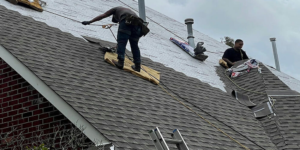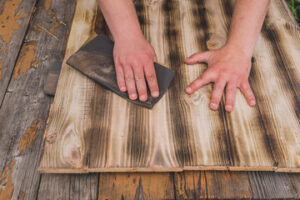A new roof is a significant investment and can increase the value of your home. A new roof will also provide many benefits that can save you money in the long run.
Oftentimes, homeowners are asked about the difference between a roof replacement and “re-roofing.” Understanding these two options can help you make an informed decision. Contact Roof Replacement Erie PA now!

A new roof can greatly enhance a home’s aesthetic and make it look more attractive to visitors and potential buyers. On the other hand, a worn out or damaged roof can detract from a property’s beauty and make it appear neglected and less well-maintained. A new roof can also add to a home’s energy efficiency by preventing conditioned air from escaping and outside air from infiltrating, which can help to keep utility bills low.
Roofing materials come in a variety of styles, colors and textures, and are available at different price points. A homeowner’s choice of roofing material often depends on a number of factors, including locality, cost, lifespan and maintenance requirements. Some common roofing materials include asphalt shingles, wood shake shingles, metal roofs and eco-friendly options like green roofs.
In addition to the main roofing material, there are a number of other materials that are needed for a successful roof replacement. These can include fascia boards and soffits, which connect to the gutter system and are located at the lower edge of the roof, as well as roof valley flashing, which helps to direct rainwater away from walls, chimneys and roof valleys.
Fascia boards and soffits are often made of wood, such as cedar or fir, while roof valley flashing is usually made of metal, such as copper. Another important component of a roof is underlayment, which acts as a barrier between the decking and the shingles and prevents water from seeping through cracks in the shingles or rotting the decking. Underlayment is typically made of a felt-like material and can be purchased in rolls or pre-cut sheets for easy installation. If underlayment is in poor condition, it will need to be replaced as part of a roof replacement.
Installation
Your roof protects your property and family from the elements of South Florida, including intense sunshine, heavy rain, and damaging winds. Whether your roof has become damaged beyond repair, or you want to upgrade its appearance and curb appeal, installing a new roof is an investment that will pay off in the long run. Choosing the right materials, hiring a qualified contractor, and making wise budget decisions will help you get the most out of your investment.
Depending on the scope of your project, you may need to obtain permits from local authorities. Your roofing contractor can assist you in navigating this process and ensuring that all necessary approvals are in place. Moreover, they will take measures to secure the safety of everyone involved in the work. For instance, they will ensure that they are working on a safe section of your roof and mark off the area to prevent passersby from falling.
Before any physical work begins on your roof, a professional will inspect it and provide you with a detailed report on its condition. The inspection will reveal any existing issues, such as leaks or structural concerns, which can be addressed before the replacement is underway. The inspection will also give you an idea of how much time and money you can expect to spend on your roof replacement.
The next step is to select the roofing materials that will best suit your needs and aesthetic preferences. There are many options to choose from, including asphalt shingles, metal roofing, and tile roofing. Your roofing contractor can help you choose the most appropriate material based on your location, roof size and complexity, and other factors.
You should also consider the cost of your chosen roofing materials. Different materials have different lifespans, so you should be sure to choose a product that will last for as long as possible and fits within your budget. Once you have selected a roofing material, you should be informed of the manufacturer’s and workmanship warranties.
Once the roofing is in place, it’s important to ensure proper ventilation. Without it, your roof’s life will be significantly shortened due to trapped heat and humidity. To prevent this from happening, your roofing contractor will install either ridge vents or attic vents. They will also replace or add pipe boots to cover any exposed plumbing pipes sticking out of your roof.
Maintenance
If your roof is over a decade old and exhibiting significant wear and tear, you may need to replace it. Roof replacement is a major investment that offers many benefits beyond the initial installation, including enhanced energy efficiency and improved curb appeal.
The best way to maximize the life and performance of your new roof is to have regular maintenance performed. Consistent service can prevent small problems from escalating into large ones. For example, an unattended leaking roof could lead to interior damage and costly emergency repairs.
When a roofing contractor comes to perform a routine maintenance inspection, they will check the condition of your shingles and roof deck. They will also check the drainage system and re-flash any open penetrations. Additionally, they will clean and dispose of debris, and inspect the attic for moisture and other problems.
In some cases, a roof replacement is the only option for your home or business. This is particularly true for homes in harsh climates, where the winter weather can be especially hard on a roof.
A roof replacement can also be a good idea if your existing roof is no longer covered by a manufacturer’s warranty. Most warranties require homeowners to have their roofs regularly inspected, and to report any issues promptly. Otherwise, the warranty may be voided.
Roof maintenance is the most important investment you can make in your roof. Not only will it prolong the life of your roof, but it will also increase its value. A well-maintained roof will look better and be more attractive than a roof with curled and stained shingles. It will also be more energy efficient, saving you money on your heating and cooling bills.
A proper attic ventilation system is critical to your roof’s lifespan. Without it, your roof will overheat and shorten its lifetime by trapping hot and cold air. During a roof replacement, your roofing contractor will replace your existing vents and ensure that you have proper attic ventilation. They will install either ridge or soffit vents, depending on the type of roof you have. They will also replace the roof plumbing boots that wrap tightly around any piping sticking out of the roof.
Insurance
Your homeowner’s insurance typically covers damage to your roof from certain covered perils. These include wind, hail, and storms, among others. Homeowners can also receive coverage for the cost to repair or replace a damaged roof up to their policy limits and deductible. However, homeowners should consider the risk/reward of filing a claim before making one. Too many claims can increase your rates or even get you dropped from the policy altogether.
The age of your roof is another factor that can impact whether or not you file a home insurance claim. Unless it’s made of a roofing material with renowned longevity, most roofs depreciate over time. Some insurers won’t cover roofs more than a few years old, while others limit the coverage to actual cash value rather than current replacement costs.
When you do decide to file a claim, working with a contractor familiar with the software insurers use to assess damage can make your case stronger. This helps ensure your claim is processed accurately and leaves the insurer less room to find exceptions that can get your claim denied.
After filing a claim, your insurer will assign an adjuster to assess the damage and determine if and how much your roof needs to be repaired or replaced. Prior to your appointment, it’s important to gather as much documentation as possible. This includes before and after photos of the roof, reports from inspectors, and a thorough understanding of your insurance policy.
It’s also a good idea to find an experienced roofing contractor familiar with working with insurance companies, which can help make the process smoother and more efficient. An expert can help you file a claim correctly and negotiate with your insurance company for a better settlement. They can also recommend preventative solutions that can reduce the number of claims you need to file in the future, saving you money and hassle down the road. One such preventative solution is installing impact-resistant shingles, which can withstand both cosmetic and functional damage from storms. In many cases, the installation of this type of shingle can lower your insurance premiums by up to 15%.
